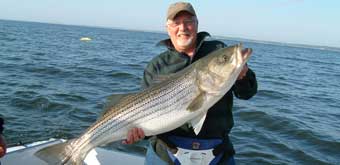
It’s a better comeback story than Rocky Balboa’s and while it’s not a hit at the box office, the return to glory for east coast striped bass is a tale worth sharing.
Popular
For decades, the Atlantic striped bass, a big shouldered brute of a fish, was a favorite of sport angers from Maine to North Carolina. Most striped bass were born in the protected waters of the Chesapeake Bay, but did most of their foraging and time in the salt water where they thrived in the expanse, gorging on the protein buffet offered by the Atlantic.
Big fish they were, strong and willing to bite, shiny and heavy. Rockfish, as Chesapeake locals still call them, and surf-caught bass often graced the covers of sporting magazines and seascape calendars as smiling fishermen strained to hold them high.
Unexplained decline
But the wheels of this fabulous fishery came off in the 1970s and 80s. So evident and alarming was the decline that the U.S. Congress engineered and passed the Emergency Striped Bass Act to determine the causes of the rapid decline and seek solutions for them.
Study teams found that acid rain was a main cause, mixing with aluminum to kill off much of the spawned bass fry while other pollutants did their damage as well. Keep in mind that 90 percent of the striped bass spawn has always taken place in the Chesapeake Bay where toxic pollutants, including treated sewage discharges, were dealing death to this great fish and other important marine life.
Fishing pressure was soon after reduced by strict regulations and by 1985 Maryland halted all striped bass fishing, a key step in allowing surviving bass to spawn.
Rebound
Improved water quality, hatchery spawned and raised stripers, data from tagged fish and reductions in fishing pressure have combined to bring striped bass back from the near dead.
While there’s still room for improvement, the fishery has regained its stature as one of the most exciting on the east coast. Each spring warming water temperatures trigger a migration into the Chesapeake bay and other tributaries where anglers try for strictly-limited, trophy-sized fish while the cool weather of mid-winter send hoards of wader-clad shore fishermen to the foam of the Atlantic surf where giant stripers cruise just a cast away from shore.
Avid anglers ought to add striped bass to their bucket list.
(Readers may contact this writer at mtontimonia@att.net.)
STAY INFORMED. SIGN UP!
Up-to-date agriculture news in your inbox!












